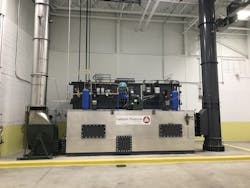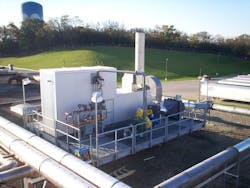Sugar Rush: Volatile Organic Compounds
Stephen H. Klostermeyer is vice president of sales and marketing for Catalytic Products Intl. Klostermeyer can be reached at [email protected].
undefinedCandy panning is a process that has been employed in the confectionary industry for years. Today, candy makers continue to utilize this process to produce panned candy products that are attractive and appealing to consumers.
Volatile organic compounds (VOCs) generated in the panning process are required by federal and state environmental regulations to be controlled. In addition to VOC regulations, the panning process can generate odors, which may cause a nuisance to surrounding communities.
Most panned candies, whether hard- or soft-coated, are polished and glazed to protect the candy and give it an attractive appearance. Polishing is the process of applying a polishing agent to the panned candy to create a smooth, glossy surface and to enhance the color of the piece. This is followed by glazing with a protective barrier to maintain product quality.
A glazing agent then is applied to protect and seal the surface from the environment, primarily against high temperatures and moisture sorption. The sealed surface also prevents the pieces from sticking together in the package.
Polishes are waxes applied in solid form or as a solution in an organic solvent. Confectioner’s glaze, also known as shellac, is composed of approximately 35% shellac with the remaining ingredients being solvents, including ethyl alcohol, ethyl acetate and acetone.
The panning process involves tumbling the edible product, such as candy and chocolate, in a revolving drum or kettle. As the product is tumbled, the edible polish or confectioner’s glaze is sprayed or ladled into the pan. As drying air is introduced to the pan to evaporate the solvents, significant emissions of VOCs are exhausted into the air handling system and released into the environment.
Thermal or catalytic oxidation are the most widely accepted control technologies available to control VOC emissions from the candy manufacturing process.
Catalytic Oxidizer
Catalytic treatment of VOCs and other air pollutants works by reacting the harmful air pollutants over a designed catalyst where VOCs are converted to harmless inert byproducts such as CO2, water vapor (H2O), and usable heat. These harmless byproducts are passed through a heat exchanger where the gas stream energy is transferred to the incoming exhaust.
An integral part of a catalytic oxidizer’s (CATOx) performance is a high velocity mixing chamber at the burner, which creates flame impingement and the turbulence needed to ensure proper mixing of the air stream. This is a critical design element of an effective catalytic oxidizer. By designing for the highest mixing, the CATOx system delivers high temperature uniformity before the catalyst bed. Temperature uniformity ensures that 100% of the catalyst is efficiently oxidizing the VOCs.
Catalytic oxidizers provide a minimum +95% VOC destruction even at the lowest flow and solvent loading. Primary heat exchangers provide for long life, high thermal efficiency and the ability to accommodate high solvent loads.
Catalytic oxidizers also provide many features for confectionary operations, including the use of a pourable bead catalyst in a split tray design, temperature uniformity, and controlled thermal expansion.
Regenerative Thermal Oxidizer
Thermal treatment of VOCs and other air pollutants works by a reaction of the harmful hydrocarbon-based air pollutants with oxygen and heat. In this environment, the VOCs are chemically oxidized to form harmless, inert byproducts. These byproducts are released to the atmosphere or used within primary or secondary energy recovery techniques to further lower operational costs.
The regenerative thermal oxidizer (RTO) system combines principles of time, temperature and turbulence, resulting in high performance, reduced operating costs, and long-lasting reliability. The RTO incorporates ceramic media in the regenerator to allow thermal efficiencies up to 97%.
RTOs operate by preheating the process air as it passes upward through the first ceramic heat exchange media. This pre-heated air then exits the heat exchange media and enters a combustion chamber where it is heated to the setpoint temperature and oxidization of the VOCs is completed at more than 98% efficiency.
The resultant hot, clean air stream is passed downward through the second ceramic heat exchange media bed, where it is cooled before being released to the atmosphere. This regeneration of the ceramic heat exchange media usually takes place in three-minute cycles, meaning that the flow through the oxidizer changes direction every three minutes. This regeneration of the heat exchanger allows for higher thermal efficiencies than traditional recuperative style heat exchangers.
The overall VOC destruction of the RTO system is dependent on three items:
- The entrained volume. The amount of air that is reversed out of the system during a valve change. Properly designed RTOs will minimize the entrained volumes, making this volume of air small.
- The amount of air bypassed. During the changing of the valves, air is allowed to pass directly to stack.
- Sealing of the valves. This is the quality of seal generated at each switch.
Fugitive Emissions & Particulate Matter
Collection of VOC emissions (referred to as “capture”) and the removal of collected VOC emissions from the exhaust airstream using an air pollution control device (referred to as “control”) are critical components in determining the overall control or control efficiency of a VOC destruction system.
In panning operations, fugitive VOC emissions often are the largest contributor affecting overall VOC control. Fugitive VOC emissions can be eliminated by effective design to collect and route the VOCs to the control device. Capture systems can include floor sweeps, permanent total enclosures (PTE), and temporary total enclosures. To provide 100% capture efficiency of the VOCs, PTE’s must meet the U.S. EPA’s requirements established in EPA Method 204.
In the panning process, it is typical to have particulate matter, including sugars, starches and other food grade ingredients in the exhaust. Over time, these types of particulates can affect oxidizer performance.
Oxidizer systems must be designed to minimize the maintenance required and optimize performance as a result of processing such exhausts. The addition of prefiltration devices prior to the oxidizer system can remove 99% submicron particulate matter, especially common in food processing applications.


